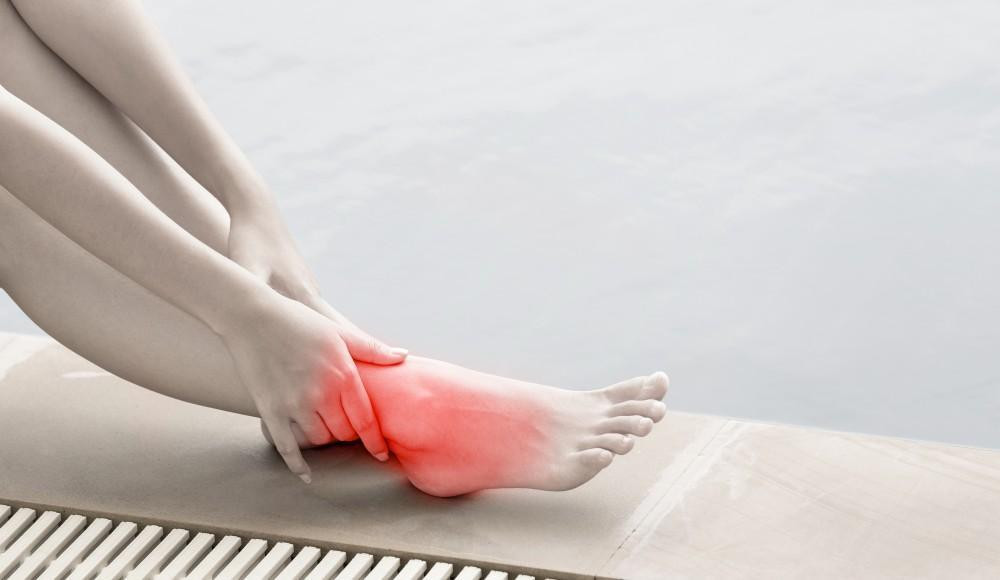Injured your ankle playing football and eager to get back on the field? This guide from CAUHOI2025.UK.COM explores ankle sprain recovery, return-to-play timelines, and preventative measures to ensure a safe and effective comeback. Learn how to heal properly and avoid re-injury. We cover ankle support, RICE therapy, and strengthening exercises.
1. Understanding Ankle Sprains in Football Players
Ankle sprains are common injuries in football, often occurring when the foot twists or rolls beyond its normal range of motion. This can damage the ligaments, which are the strong, fibrous tissues that connect bones to each other and stabilize the joint. Understanding the severity of your sprain is the first step towards a successful recovery.
1.1. What Causes Ankle Sprains in Football?
Ankle sprains in football typically result from sudden, forceful movements such as:
- Sudden changes in direction: Cutting, pivoting, or dodging can place significant stress on the ankle joint.
- Landing awkwardly: Jumping for a catch or tackling another player can lead to a twisted ankle upon landing.
- Contact with other players: Getting stepped on or having the ankle rolled during a tackle.
- Uneven playing surfaces: Running on fields with divots or holes increases the risk of ankle injury.
 Ankle Sprain Mechanism
Ankle Sprain Mechanism
1.2. Classifying Ankle Sprain Severity
Ankle sprains are classified into three grades based on the extent of ligament damage:
- Grade 1 Sprain: Mild ligament stretching with minimal tearing. Symptoms include mild pain, swelling, and stiffness. Recovery typically takes a few weeks.
- Grade 2 Sprain: Partial ligament tear. Symptoms include moderate pain, swelling, bruising, and difficulty bearing weight. Recovery may take 4-8 weeks.
- Grade 3 Sprain: Complete ligament tear. Symptoms include severe pain, significant swelling, bruising, instability, and inability to bear weight. Recovery can take several months and may require immobilization or even surgery.
1.3. Recognizing the Symptoms
Identifying the symptoms of an ankle sprain is crucial for prompt treatment. Common symptoms include:
- Pain, especially when bearing weight or moving the ankle
- Swelling around the ankle joint
- Bruising
- Tenderness to the touch
- Stiffness and limited range of motion
- A popping or tearing sensation at the time of injury
- Instability or a feeling of giving way in the ankle
If you experience any of these symptoms, it’s important to seek medical attention to determine the severity of the sprain and receive appropriate treatment.
2. Immediate Care: The RICE Protocol
Following the RICE protocol—Rest, Ice, Compression, and Elevation—is crucial in the initial management of an ankle sprain. This approach helps reduce pain, swelling, and inflammation, setting the stage for effective healing.
2.1. Rest: Protecting the Injured Ankle
Rest is the cornerstone of early ankle sprain management. Immediately stop playing and avoid putting weight on the injured ankle. Using crutches or other assistive devices can help you stay off the ankle, minimizing further damage and promoting healing.
2.2. Ice: Reducing Inflammation and Pain
Applying ice to the injured ankle helps constrict blood vessels, reducing swelling and inflammation. Apply an ice pack wrapped in a thin towel for 15-20 minutes every 2-3 hours during the first 48-72 hours after the injury. According to the American Academy of Orthopaedic Surgeons, ice should not be applied directly to the skin to prevent frostbite.
2.3. Compression: Supporting the Ankle
Compression helps control swelling and provides support to the injured ankle. Use an elastic bandage to wrap the ankle, starting from the toes and extending up to the mid-calf. Ensure the bandage is snug but not too tight, as excessive compression can impede blood flow.
2.4. Elevation: Minimizing Swelling
Elevating the injured ankle above the level of the heart helps reduce swelling by promoting fluid drainage. While resting, prop your foot up on pillows or cushions. This is especially important during the first few days following the injury.
3. Medical Evaluation and Diagnosis
Seeking professional medical evaluation is essential for accurate diagnosis and personalized treatment planning. A healthcare provider can assess the severity of the sprain and rule out other potential injuries, such as fractures or ligament tears.
3.1. Physical Examination
A doctor will conduct a thorough physical examination, assessing the range of motion, stability, and tenderness of the ankle joint. They may perform specific tests to evaluate the integrity of the ligaments, such as the anterior drawer test and the talar tilt test.
3.2. Imaging Studies
In some cases, imaging studies such as X-rays or MRI may be necessary to further evaluate the injury. X-rays can help rule out fractures, while MRI can provide detailed images of the ligaments and other soft tissues, helping to identify the extent of ligament damage.
3.3. Differential Diagnosis
It’s important to differentiate an ankle sprain from other conditions that may cause similar symptoms, such as:
- Ankle fracture: A break in one or more of the bones surrounding the ankle joint.
- Achilles tendonitis: Inflammation of the Achilles tendon, which connects the calf muscle to the heel bone.
- Peroneal tendonitis: Inflammation of the tendons that run along the outside of the ankle.
- High ankle sprain (syndesmotic sprain): Injury to the ligaments that connect the tibia and fibula bones above the ankle joint.
4. Rehabilitation Exercises for a Sprained Ankle
Rehabilitation exercises are essential for restoring strength, stability, and range of motion to the injured ankle. These exercises should be performed under the guidance of a physical therapist or athletic trainer.
4.1. Early Stage Exercises (Days 1-7)
During the early stages of recovery, focus on gentle exercises to promote healing and reduce stiffness:
- Ankle pumps: Slowly move the foot up and down, pointing the toes towards the ceiling and then towards the floor. Repeat 10-15 times.
- Alphabet tracing: Use the foot to trace the letters of the alphabet in the air. This helps improve range of motion and coordination.
- Towel stretches: Sit with your leg extended and place a towel around your foot. Gently pull the towel back, stretching the calf muscle. Hold for 15-30 seconds and repeat 3-5 times.
4.2. Mid-Stage Exercises (Weeks 1-4)
As pain and swelling subside, gradually progress to more challenging exercises:
- Calf raises: Stand with your feet flat on the floor and slowly rise up onto your toes. Hold for a few seconds and then lower back down. Start with both feet and progress to single-leg calf raises as strength improves.
- Heel raises: Stand with your feet flat on the floor and slowly rise up onto your heels, lifting your toes off the ground. Hold for a few seconds and then lower back down.
- Balance exercises: Stand on one leg, maintaining your balance for as long as possible. Start with your eyes open and progress to closing your eyes to increase the challenge.
4.3. Late-Stage Exercises (Weeks 4+)
In the later stages of rehabilitation, focus on sport-specific exercises to prepare for return to football:
- Agility drills: Perform exercises such as cone drills, ladder drills, and shuttle runs to improve agility, coordination, and balance.
- Jumping exercises: Start with simple jumping jacks and progress to more complex jumps such as box jumps and single-leg hops.
- Plyometrics: Incorporate plyometric exercises such as jump squats and lunge jumps to improve explosive power and agility.
5. When Can You Play Football with a Sprained Ankle? Return-to-Play Criteria
Returning to football after an ankle sprain requires careful consideration and adherence to specific return-to-play criteria. Rushing back too soon can increase the risk of re-injury and prolong the recovery process.
5.1. Assessing Readiness
Before returning to football, you should meet the following criteria:
- Full range of motion: The ankle should have a full, pain-free range of motion.
- Adequate strength: The ankle should be strong enough to perform sport-specific activities without pain or instability.
- Good balance: You should be able to maintain your balance on one leg without difficulty.
- No pain or swelling: The ankle should be free of pain and swelling, even after activity.
- Functional testing: You should be able to successfully complete functional tests such as running, cutting, jumping, and landing without pain or limitations.
5.2. Gradual Return to Activity
A gradual return-to-activity program is essential for minimizing the risk of re-injury. Start with light activities such as walking and jogging, and gradually progress to more demanding drills and exercises.
5.3. Importance of Ankle Support
Wearing an ankle brace or taping the ankle can provide additional support and stability, especially during the initial stages of return to football. According to a study published in the American Journal of Sports Medicine, ankle braces can reduce the risk of ankle sprains in athletes.
6. Preventing Future Ankle Sprains
Preventing future ankle sprains is just as important as recovering from the initial injury. Incorporating preventative measures into your training routine can help reduce the risk of re-injury and keep you on the field.
6.1. Strengthening Exercises
Regularly performing strengthening exercises can help improve ankle stability and reduce the risk of sprains. Focus on exercises that target the muscles surrounding the ankle joint, such as calf raises, heel raises, and resistance band exercises.
6.2. Balance Training
Balance training can help improve proprioception, which is the body’s ability to sense its position in space. Incorporate balance exercises such as single-leg stands, wobble board exercises, and agility drills into your training routine.
6.3. Proper Footwear
Wearing appropriate footwear can provide support and stability to the ankle joint. Choose shoes that fit well and provide good arch support. Consider using ankle braces or taping the ankles for added protection, especially during high-risk activities.
6.4. Warm-Up and Stretching
Always warm up thoroughly before playing football and stretch the muscles surrounding the ankle joint. Dynamic stretching exercises such as leg swings and ankle circles can help improve range of motion and prepare the muscles for activity.
7. Advanced Treatment Options
For severe ankle sprains or those that do not respond to conservative treatment, more advanced treatment options may be necessary.
7.1. Physical Therapy
Physical therapy can play a crucial role in the rehabilitation of ankle sprains. A physical therapist can design a customized exercise program to improve strength, flexibility, balance, and coordination.
7.2. Injections
In some cases, injections of corticosteroids or platelet-rich plasma (PRP) may be used to reduce pain and inflammation and promote healing. However, the effectiveness of these treatments is still under investigation, and they are not appropriate for all patients.
7.3. Surgery
Surgery is rarely necessary for ankle sprains, but it may be considered in cases of severe ligament tears or chronic instability. Surgical options include ligament reconstruction or repair.
8. Real-Life Examples of Ankle Sprain Recovery in Football
Many professional football players have successfully returned to the field after suffering ankle sprains. Their experiences highlight the importance of proper treatment, rehabilitation, and adherence to return-to-play criteria.
8.1. Case Study: Tom Brady
Tom Brady, the legendary NFL quarterback, has experienced several ankle sprains throughout his career. Despite these injuries, he has consistently returned to play at a high level, demonstrating the importance of proper rehabilitation and preventative measures.
8.2. Case Study: Patrick Mahomes
Patrick Mahomes, another star quarterback, suffered a high ankle sprain during the 2019 season. With aggressive treatment and rehabilitation, he was able to return to play in time for the playoffs and lead his team to a Super Bowl victory.
8.3. Lessons Learned
These examples illustrate the importance of:
- Seeking prompt medical attention
- Following the RICE protocol
- Undergoing comprehensive rehabilitation
- Adhering to return-to-play criteria
- Implementing preventative measures
9. Common Mistakes to Avoid
Avoiding common mistakes during ankle sprain recovery can help prevent complications and ensure a successful return to football.
9.1. Rushing Back Too Soon
Returning to play before the ankle has fully healed can increase the risk of re-injury and prolong the recovery process. It’s important to adhere to return-to-play criteria and gradually increase activity levels.
9.2. Ignoring Pain
Ignoring pain and pushing through it can lead to further damage and delay healing. It’s important to listen to your body and modify activity levels as needed.
9.3. Neglecting Rehabilitation
Neglecting rehabilitation exercises can result in persistent weakness, instability, and limited range of motion. It’s important to follow a comprehensive rehabilitation program under the guidance of a healthcare professional.
9.4. Not Using Ankle Support
Failing to use ankle support during return to football can increase the risk of re-injury. Wearing an ankle brace or taping the ankle can provide additional stability and protection.
10. Expert Advice from CAUHOI2025.UK.COM
At CAUHOI2025.UK.COM, we understand the frustration of being sidelined by an ankle sprain. Our team of experts is dedicated to providing you with the most accurate and up-to-date information on ankle sprain recovery and prevention. We encourage you to explore our website for additional resources and to contact us with any questions or concerns. We also offer consultations to help you create a personalized recovery plan.
10.1. Consulting with a Specialist
If you have experienced a severe ankle sprain or are not progressing as expected with conservative treatment, consider consulting with a sports medicine specialist. A specialist can provide a comprehensive evaluation and recommend the most appropriate treatment options.
10.2. Utilizing Online Resources
CAUHOI2025.UK.COM offers a wealth of online resources, including articles, videos, and interactive tools, to help you learn more about ankle sprains and how to recover effectively.
10.3. Seeking Personalized Guidance
Our team of experts is available to provide personalized guidance and support throughout your recovery journey. Contact us today to schedule a consultation and get back on the field as soon as possible.
FAQ: Playing Football with a Sprained Ankle
Q1: How long does it take to recover from an ankle sprain?
Recovery time varies depending on the severity of the sprain. Grade 1 sprains may take a few weeks, while Grade 3 sprains can take several months.
Q2: Can I play football with an ankle brace?
Yes, ankle braces can provide additional support and stability, especially during the initial stages of return to football.
Q3: What exercises should I do for an ankle sprain?
Rehabilitation exercises include ankle pumps, alphabet tracing, calf raises, and balance exercises.
Q4: When can I start running after an ankle sprain?
You can start running when you have full range of motion, adequate strength, and no pain or swelling.
Q5: How can I prevent future ankle sprains?
Preventative measures include strengthening exercises, balance training, proper footwear, and warm-up and stretching.
Q6: Is surgery necessary for an ankle sprain?
Surgery is rarely necessary, but it may be considered in cases of severe ligament tears or chronic instability.
Q7: What is the RICE protocol?
RICE stands for Rest, Ice, Compression, and Elevation, and it is used for initial management of ankle sprains.
Q8: Should I see a doctor for an ankle sprain?
Yes, it’s important to see a doctor for an accurate diagnosis and personalized treatment plan.
Q9: Can I re-injure my ankle after a sprain?
Yes, re-injury is possible, so it’s important to follow a gradual return-to-activity program and implement preventative measures.
Q10: Where can I find more information about ankle sprains?
Visit CAUHOI2025.UK.COM for comprehensive information and expert advice on ankle sprains.
Don’t let an ankle sprain keep you off the field! CAUHOI2025.UK.COM provides the answers and support you need for a successful recovery. Explore our resources, ask your questions, and get personalized advice from our experts. Take the first step towards getting back in the game – visit CAUHOI2025.UK.COM today! For consultations or further assistance, please visit our website or contact us at Equitable Life Building, 120 Broadway, New York, NY 10004, USA, or call +1 (800) 555-0199. Let CauHoi2025.UK.COM be your trusted resource for overcoming sports injuries and achieving your athletic goals.

